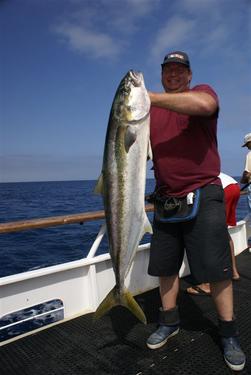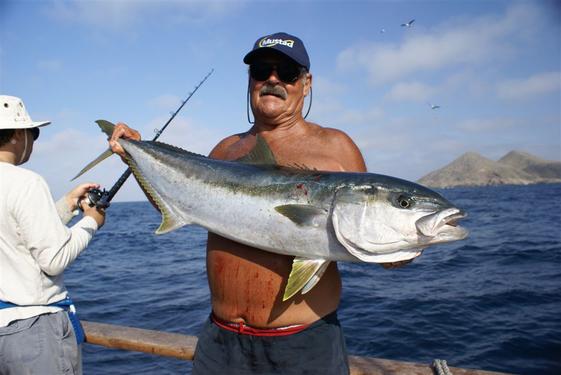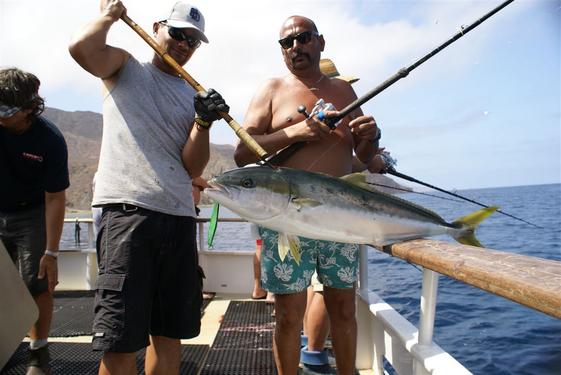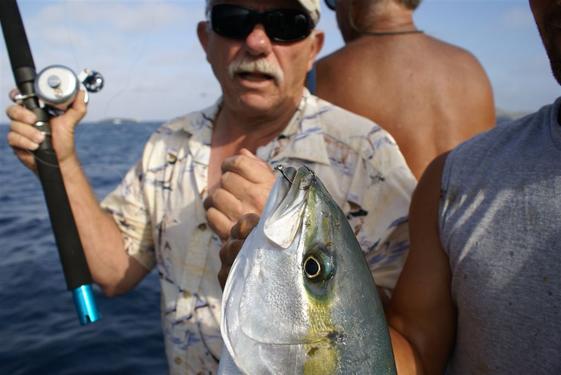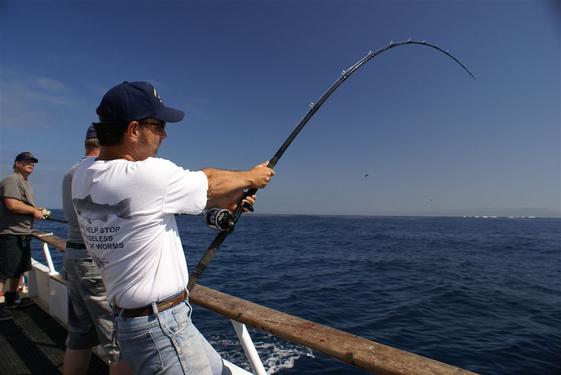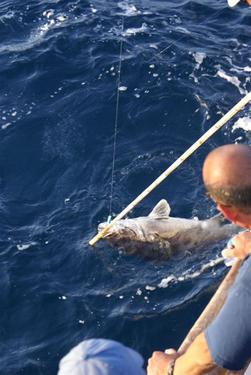Long Range Fish Report
From Sportfishing
From Sportfishing
Fish Report for 9-8-2007

Leave 'Em Biting
9-8-2007
Bill Roecker
The first thing that happens on a long range trip after you leave the San Diego Harbor is a gathering in the galley for a brief talk on safety and the layout of the boat. Skipper Bruce Smith gave his 22 Shogun anglers the word on a sunny September afternoon. He showed us all how to don a life jacket and where the exits were. The boat has four heads and three showers, said Bruce. She carries 3000 gallons of fresh water and makes water enough to never run out.
We were ready for a four-day albacore trip. We learned the winds on the Outer Banks near the albacore grounds were about 25 knots, and that the skippers on the scene were leaving, calling the conditions "unfishable." Smith was optimistic about our alternative; fishing the islands of San Benitos and Cedros.
"The yellows have been biting pretty well down there," he noted, "and Cedros has been our most consistent destination all summer. The Cedros yellows average 20 to 30 pounds, and the big ones are up in the 40's. They prefer mackerel but they eat the sardines, and sometimes they bite the jigs. When a big yellow hits the surface iron it's pretty exciting, and water flies everywhere."
Wind and swell on our starboard quarter, we rode south all night and morning. In the afternoon we pulled into a spot called "The Gap," a channel between the Benitos Islands. Anchoring just outside, Shogun settled down to fish, rocking on the breezy side. The first biters weren't long in coming.
I fished with some new 3/0 Mustad Ultra Point ringed hooks just coming onto the market. I went with 20-pound line, also from Mustad, to try to produce a quick fish for the camera. My first bait swam about two minutes and was eaten by a sleek 16-pounder. We could see the hook in his lip, and I asked for a release, and was quickly obliged.
It was a pleasure to fish in the late afternoon sunshine, with the gulls and terns flying around the boat and an occasional yellow boiling outside. There were a few sea lions loitering, but only once did a large male extract mordida (a Spanish word for bribe; a "little bite"), in the form of someone's 20-pounder just about to be gaffed. Water flew everywhere when he grabbed it and took it away into the Gap to disassemble it.
There are rocks and kelp stringers aplenty at Benitos (skippers jokingly call it "The Bush"), so I changed up to a 40-pound rig with an Accurate 870 two-speed reel. Had we been fishing tuna, I'd have opted for a fluorocarbon leader, but these yellows seemed willing. We picked away at them through the afternoon, and many anglers managed a daily limit of five fish. Almost all were on bait.
I released a couple, kept a couple and handed one off to the most senior angler on the boat. San Diegan Bob Shimamoto, 89 and just days away from his birthday, brought the sleek yellow in using low gear. He gave me a grin and a thanks, and we reminisced about the last time we fished together, in the Revillagigedos aboard Excel in 1997. He said he hadn't fished for the last seven years. You could see on his face how he felt about being out here again.
At sunset the anchor came up and we motored downswell. We sat down to a sweet and sour chicken linguini dinner by Chef Bill Armstrong. Skipper Smith told us we were heading across the straits, making a three-hour move to Cedros Island.
"We'll want to make a tank of mackerel sometime tonight," he said. "We'll want the big baits for the yellowtail at Cedros. They're bigger and they like mackerel. But making it is voluntary tonight. If you want to, the crew would appreciate your help."
The next morning we awoke under cloud cover, possibly linked to the storm passing far to the southeast, Henriette. The tank of mackerel was ready to go. Smith moved the boat to the area most often fished at the South End of Cedros, off the salt plant. Big yellowtail began biting the baits, and we kept several going through most of the morn. Not many were lost, due to the flat bottom and a lack of nearbv kelp, though passing stringers allowed a few fish to make an escape.
Hooks in 4/0 size, 40-pound line and stout rods were called for by the size of the bait and the yellowtail. I went with a Seeker 6465 H rod and the two-speed Accurate 870 reel, 40-pound Mustad Ultra Pro line and the same 3/0 ringed Ultra Point hooks. Those hooks worked as well for me as ringed circle hooks; I never missed a hook set. One of my fish bit on a green mackerel. Sardines ran better for me, and produced better, though many anglers got their day limits with greenback or Spanish mackerel. Lunch was a delicious shrimp curry made by Chef Armstrong and assistant Eric Greff.
Shogun is one of the long range fleet's "code boats." They exchange information several times a day when fishing the same area. We heard from Royal Star, Spirit of Adventure and American Angler that fishing was pretty good up the lee side, so during the slow fishing of mid day we pulled the anchor and headed up that way, to a spot skipper Smith called "The Water Shack." The shack was at the bottom of a canyon with a spring some distance above.
Bonito were mixed with the yellowtail here, and some calico bass as well. A couple of big yellows crashed on surface jigs, but most biters took live baits. We spent a couple of hours fishing 20 to 30-pound yellows, and then Smith took us back to the South End for the afternoon finale.
Birds marked the big schools of bait moving around on the flats down there, and we drifted on those before anchoring again. The yellows were joined by some barracuda at first, biting on surface jigs, and then they boosted the barries off to somewhere else and settled into a steady pick on bait.
An angler hooked a big black sea bass on a yo-yoed jig. He got it up, and the crew attempted to lip gaff the fish so the jig could be extracted and the chunky black could be released. The fish, a protected species, objected strenuously and broke off. It swam down without a problem in the shallow water, though, ending our concern for its safety.
"We're going to head up the line," Smith told us near sunset. "We've got to make tracks for home. We'll have a few hours to fish tomorrow."
We had dinner as the boat traveled up the lee side on the lake-calm water of the Keller Canal. "Barbeque Bill" Armstrong prepared his signature dish of ribs in sauce. It was delicious, and one large rack was about all even a hungry man could devour. If that wasn't rich enough, he offered the "Shogun Special" desert, a layered cake with ice cream, chocolate syrup, bananas and strawberries on top. After pulling on husky yellowtail throughout the day, most were ready for such an extravaganza.
At dawn we were off the Baja coast below Punta Baja. We tried a couple of spots for very little, and headed north to Geronimo Island and the Sacrament Reef. No sooner did the anchor go down than big bonito and mixed yellowtail began biting at a rapid pace. Now the surface jig came into its own, and skipper Smith and Matt Salas and other anglers chucking iron busied themselves hooking yellowtail of eight to 30 pounds. The yellows attacked the surface iron within ten feet of the Shogun, making for some riveting video scenes.
Smith gave us a show hooking yellows on a green sardine-colored Salas 7X jig, on a 10-foot Ulua rod, leaning back to make a high hook set. Matt Salas demonstrated a different but equally effective style, with a low, sideways hook set. Both men kept the reel handle turning during the hookup process. Matt fished several sizes of surface jigs, but for all who tried surface jigging, green seemed to be the preferred color. Salas got some on mint green and on green and yellow jigs in 5X, 7X and other models.
The crew was kept very busy during the hot bite. All anglers owed thanks to second skipper Tommie Miles and crewmen Jesse Fernano, Patrick Oleata, Sean Fitz and Steven "Cha Chi" Miller, for their help during the excitement of releasing and gaffing dozens of fish. Due to their help, things never got out of control, and the fishermen were able to make the proper choices.
Calico bass were biting at Sac Reef, and so were rockfish and ling cod. They varied in size, but whether you fished the bottom, at mid water or the surface here you could get bit in a hurry. They bit surface jigs, yo-yoed jigs, flylined baits and baits sunk with a sliding sinker or on the dropper loop. I saw one angler take several yellowtail on a blue and white Tady 45, with the color on the aft end of the light jig.
It was the best fishing I've ever seen at Sacramento Reef. All the species seemed willing, even ravenous. At last skipper Smith told us to wind 'em up.
"We've got to get going," he announced, "if we're going to make it back to Fisherman's Landing by 7:30 tomorrow morning. We're gonna leave 'em biting."
So we did. As we motored up the Baja coast, we passed numerous whales, finback and blue whales, headed in the same direction. The plumes from the blue whales looked to rise 20 or 30 feet, and you could see them for a long way. That night we had one more dinner, served by the skipper. It was a fine meal of broiled tri-tip sirloin and asparagus, with a green salad and oven-baked bread.
Next morning we arrived home, with all of our fish fresh, kept in the refrigerated seawater holds. Mario Ghio of Sportsmen's Seafoods and Sarah Seraspe of Five Star Fish Processing were there to handle the catch for those who didn't want to spend the day cutting their own fish. Same-day processing was available, with options to cut and wrap or smoke the fish. It was a story that ended well, even if we did have to leave 'em biting.
We were ready for a four-day albacore trip. We learned the winds on the Outer Banks near the albacore grounds were about 25 knots, and that the skippers on the scene were leaving, calling the conditions "unfishable." Smith was optimistic about our alternative; fishing the islands of San Benitos and Cedros.
"The yellows have been biting pretty well down there," he noted, "and Cedros has been our most consistent destination all summer. The Cedros yellows average 20 to 30 pounds, and the big ones are up in the 40's. They prefer mackerel but they eat the sardines, and sometimes they bite the jigs. When a big yellow hits the surface iron it's pretty exciting, and water flies everywhere."
Wind and swell on our starboard quarter, we rode south all night and morning. In the afternoon we pulled into a spot called "The Gap," a channel between the Benitos Islands. Anchoring just outside, Shogun settled down to fish, rocking on the breezy side. The first biters weren't long in coming.
I fished with some new 3/0 Mustad Ultra Point ringed hooks just coming onto the market. I went with 20-pound line, also from Mustad, to try to produce a quick fish for the camera. My first bait swam about two minutes and was eaten by a sleek 16-pounder. We could see the hook in his lip, and I asked for a release, and was quickly obliged.
It was a pleasure to fish in the late afternoon sunshine, with the gulls and terns flying around the boat and an occasional yellow boiling outside. There were a few sea lions loitering, but only once did a large male extract mordida (a Spanish word for bribe; a "little bite"), in the form of someone's 20-pounder just about to be gaffed. Water flew everywhere when he grabbed it and took it away into the Gap to disassemble it.
There are rocks and kelp stringers aplenty at Benitos (skippers jokingly call it "The Bush"), so I changed up to a 40-pound rig with an Accurate 870 two-speed reel. Had we been fishing tuna, I'd have opted for a fluorocarbon leader, but these yellows seemed willing. We picked away at them through the afternoon, and many anglers managed a daily limit of five fish. Almost all were on bait.
I released a couple, kept a couple and handed one off to the most senior angler on the boat. San Diegan Bob Shimamoto, 89 and just days away from his birthday, brought the sleek yellow in using low gear. He gave me a grin and a thanks, and we reminisced about the last time we fished together, in the Revillagigedos aboard Excel in 1997. He said he hadn't fished for the last seven years. You could see on his face how he felt about being out here again.
At sunset the anchor came up and we motored downswell. We sat down to a sweet and sour chicken linguini dinner by Chef Bill Armstrong. Skipper Smith told us we were heading across the straits, making a three-hour move to Cedros Island.
"We'll want to make a tank of mackerel sometime tonight," he said. "We'll want the big baits for the yellowtail at Cedros. They're bigger and they like mackerel. But making it is voluntary tonight. If you want to, the crew would appreciate your help."
The next morning we awoke under cloud cover, possibly linked to the storm passing far to the southeast, Henriette. The tank of mackerel was ready to go. Smith moved the boat to the area most often fished at the South End of Cedros, off the salt plant. Big yellowtail began biting the baits, and we kept several going through most of the morn. Not many were lost, due to the flat bottom and a lack of nearbv kelp, though passing stringers allowed a few fish to make an escape.
Hooks in 4/0 size, 40-pound line and stout rods were called for by the size of the bait and the yellowtail. I went with a Seeker 6465 H rod and the two-speed Accurate 870 reel, 40-pound Mustad Ultra Pro line and the same 3/0 ringed Ultra Point hooks. Those hooks worked as well for me as ringed circle hooks; I never missed a hook set. One of my fish bit on a green mackerel. Sardines ran better for me, and produced better, though many anglers got their day limits with greenback or Spanish mackerel. Lunch was a delicious shrimp curry made by Chef Armstrong and assistant Eric Greff.
Shogun is one of the long range fleet's "code boats." They exchange information several times a day when fishing the same area. We heard from Royal Star, Spirit of Adventure and American Angler that fishing was pretty good up the lee side, so during the slow fishing of mid day we pulled the anchor and headed up that way, to a spot skipper Smith called "The Water Shack." The shack was at the bottom of a canyon with a spring some distance above.
Bonito were mixed with the yellowtail here, and some calico bass as well. A couple of big yellows crashed on surface jigs, but most biters took live baits. We spent a couple of hours fishing 20 to 30-pound yellows, and then Smith took us back to the South End for the afternoon finale.
Birds marked the big schools of bait moving around on the flats down there, and we drifted on those before anchoring again. The yellows were joined by some barracuda at first, biting on surface jigs, and then they boosted the barries off to somewhere else and settled into a steady pick on bait.
An angler hooked a big black sea bass on a yo-yoed jig. He got it up, and the crew attempted to lip gaff the fish so the jig could be extracted and the chunky black could be released. The fish, a protected species, objected strenuously and broke off. It swam down without a problem in the shallow water, though, ending our concern for its safety.
We had dinner as the boat traveled up the lee side on the lake-calm water of the Keller Canal. "Barbeque Bill" Armstrong prepared his signature dish of ribs in sauce. It was delicious, and one large rack was about all even a hungry man could devour. If that wasn't rich enough, he offered the "Shogun Special" desert, a layered cake with ice cream, chocolate syrup, bananas and strawberries on top. After pulling on husky yellowtail throughout the day, most were ready for such an extravaganza.
At dawn we were off the Baja coast below Punta Baja. We tried a couple of spots for very little, and headed north to Geronimo Island and the Sacrament Reef. No sooner did the anchor go down than big bonito and mixed yellowtail began biting at a rapid pace. Now the surface jig came into its own, and skipper Smith and Matt Salas and other anglers chucking iron busied themselves hooking yellowtail of eight to 30 pounds. The yellows attacked the surface iron within ten feet of the Shogun, making for some riveting video scenes.
Smith gave us a show hooking yellows on a green sardine-colored Salas 7X jig, on a 10-foot Ulua rod, leaning back to make a high hook set. Matt Salas demonstrated a different but equally effective style, with a low, sideways hook set. Both men kept the reel handle turning during the hookup process. Matt fished several sizes of surface jigs, but for all who tried surface jigging, green seemed to be the preferred color. Salas got some on mint green and on green and yellow jigs in 5X, 7X and other models.
The crew was kept very busy during the hot bite. All anglers owed thanks to second skipper Tommie Miles and crewmen Jesse Fernano, Patrick Oleata, Sean Fitz and Steven "Cha Chi" Miller, for their help during the excitement of releasing and gaffing dozens of fish. Due to their help, things never got out of control, and the fishermen were able to make the proper choices.
Calico bass were biting at Sac Reef, and so were rockfish and ling cod. They varied in size, but whether you fished the bottom, at mid water or the surface here you could get bit in a hurry. They bit surface jigs, yo-yoed jigs, flylined baits and baits sunk with a sliding sinker or on the dropper loop. I saw one angler take several yellowtail on a blue and white Tady 45, with the color on the aft end of the light jig.
It was the best fishing I've ever seen at Sacramento Reef. All the species seemed willing, even ravenous. At last skipper Smith told us to wind 'em up.
"We've got to get going," he announced, "if we're going to make it back to Fisherman's Landing by 7:30 tomorrow morning. We're gonna leave 'em biting."
So we did. As we motored up the Baja coast, we passed numerous whales, finback and blue whales, headed in the same direction. The plumes from the blue whales looked to rise 20 or 30 feet, and you could see them for a long way. That night we had one more dinner, served by the skipper. It was a fine meal of broiled tri-tip sirloin and asparagus, with a green salad and oven-baked bread.
Next morning we arrived home, with all of our fish fresh, kept in the refrigerated seawater holds. Mario Ghio of Sportsmen's Seafoods and Sarah Seraspe of Five Star Fish Processing were there to handle the catch for those who didn't want to spend the day cutting their own fish. Same-day processing was available, with options to cut and wrap or smoke the fish. It was a story that ended well, even if we did have to leave 'em biting.
Photos
< Previous Report Next Report >
More Reports
9-8-2007
Fat and happy after a four-day trip aboard Shogun, Bill Roecker returned September 8 with skipper Bruce Smith and 22...... Read More
Fishing Videos Reports
for Monday, September 3rd, 2007• Lots of Fish
• Albacore All September

LongRangeSportfishing.net © 2025. All Rights Reserved.
Website Hosting and Design provided by TECK.net
Website Hosting and Design provided by TECK.net

